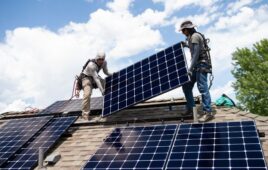The SUN DAY Campaign analyzed the latest data from the U.S. EIA and found that renewable energy sources accounted for 20.45% of total U.S. electrical generation in the first three quarters of 2021.
Solar increased by 24.61% and wind increased 10.89% compared to the same nine-month period in 2020. Combined, they grew by 15% and accounted for more than one-eighth (12.59%) of U.S. electrical generation (wind: 8.50%, solar: 4.09%). Moreover, wind and solar combined now provide 61.55% of the generation by renewable sources.
In addition, geothermal posted a gain of 2.75% while electricity generated by wood and other biomass increased by 1.71%. Combined, all non-hydro renewables grew by 12.8%.
Reflecting worsening drought conditions, though, hydropower fell by 12.47%. Nonetheless, all renewables combined — including hydropower — produced 4.05% more electricity than a year earlier. However, as electricity generation by all sources increased by 3.26%, renewables’ share of the total increased only slightly — from 20.30% in 2020 to 20.45% this year.
Renewable sources also expanded their lead over nuclear power, providing 10.72% more electricity than the nation’s atomic power plants (18.47% of the total). Natural gas remained as the top source of U.S. electrical generation with a 37.57% share but down from 40.75% a year ago. Coal rebounded into second place (with a 22.60% share), growing 25.31% compared to the first three-quarters of 2020.
Longer-term trends, though, still suggest the gradual and probably accelerating displacement of coal and nuclear power by renewable energy sources, especially solar and wind. Compared to the first nine months of 2016, coal-generated electricity has declined by 23.08% and nuclear power is down by 5.33%. Meanwhile, renewables’ share of total electrical generation has grown from 15.10% to 20.45% with wind expanding by 65.23% and solar increasing three-fold.
“Inasmuch as they have maintained an overall faster rate of growth than any other energy sources over the past half-decade and longer, it seems safe to say that solar and wind will eventually become the nation’s primary electrical producers,” noted the SUN DAY Campaign’s executive director Ken Bossong. “They now have a growing lead over nuclear power; surpassed coal in 2020 and will likely do so again next year; and are rapidly cutting into natural gas’s current dominance.”
News item from SUN DAY






“Renewable sources also expanded their lead over nuclear power, providing 10.72% more electricity than the nation’s atomic power plants (18.47% of the total). Natural gas remained as the top source of U.S. electrical generation with a 37.57% share but down from 40.75% a year ago. Coal rebounded into second place (with a 22.60% share), growing 25.31% compared to the first three-quarters of 2020.”
The larger problem is with the rote IOU electric utilities using solar PV or wind generation like say a natural gas Peaker plant and all the while complaining about the intermittency of solar PV and wind generation. Throw away ‘non-fueled’ energy generation to use fueled generation resources as capacity creates more inefficiency in the overall grid operations. All wind and solar PV from now on in the utility scale sector should have several MWh of energy storage as part of the project or several GWh energy storage facilities should be constructed distributed along the transmission grid to service regional energy needs. The electricity industry as a whole doesn’t seem to grasp that well connected, large scale energy storage abrogates slow fueled generation to address grid load demands. I do find it interesting that Natural gas generation is down from last year as it has been the ‘go to’ mechanical generation fuel of choice for maybe the last 10 years now. There’s still enough coal fired plants in the energy mix that these will be targeted by natural gas driven generation capacity as coal plants are decommissioned. Without at least one large electric utility taking the leap and constructing some kind of GWh energy storage facility, perhaps redox flow battery technology, then natural gas generation will once again increase, while decommissioning more fueled generation should be the ultimate goal, including faster decommissioning for natural gas generation country wide.